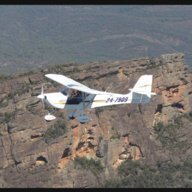Hi recflyer. I usually pull on full flap under 75 knots on late base to final. As a former glider pilot, I tend to set up for a rather high but steep final (which helps keep me above any unseen power lines at unfamiliar ALA's). Sideslips with full flaps are permitted, and they are well mannered, thanks to the hanging flaperon config. Once over the threshold fence I'm generally just under 60 knots, and really washing off this excess speed on a longish & flat flare to my aiming point. The main gear is robust and wide, so stability on the ground is good. There is still good control authority upon touchdown to keep the nosewheel off as I tend to do at my local (often wet) grass strip (YLIL).
Soft field take-offs I do with full flaperon (yes, full...) Being full length, the maximum flap angle is only around 15 degrees, so it is more lift, than drag producing. Though I haven't actually measured it, solo with under 1/4 tanks, I'm off a hard surface in around 80 metres, I estimate. I hope this is the info you wanted. Horsham Aviation are the (very capable) agents for Eurofox in Australia, if you want to follow-up on this aircraft further. I also have them do all my maintenance, and they are as meticulous as the factory that builds them. Happy flying...








